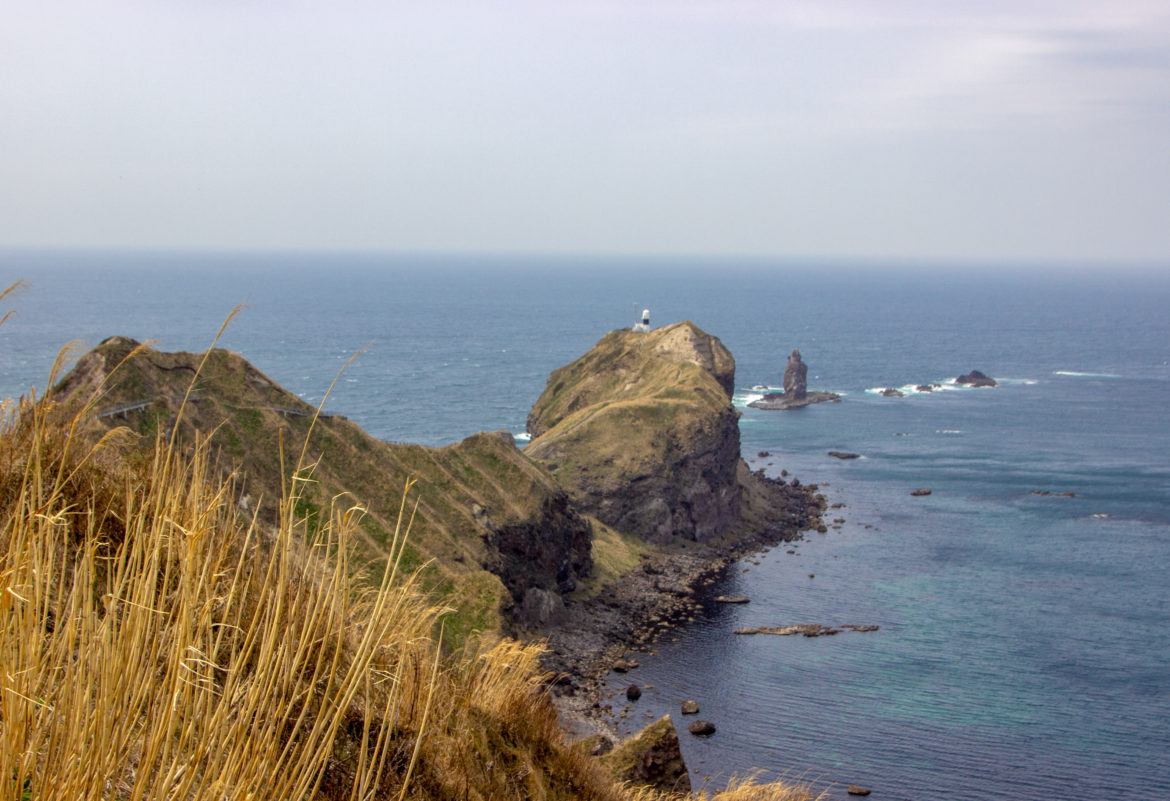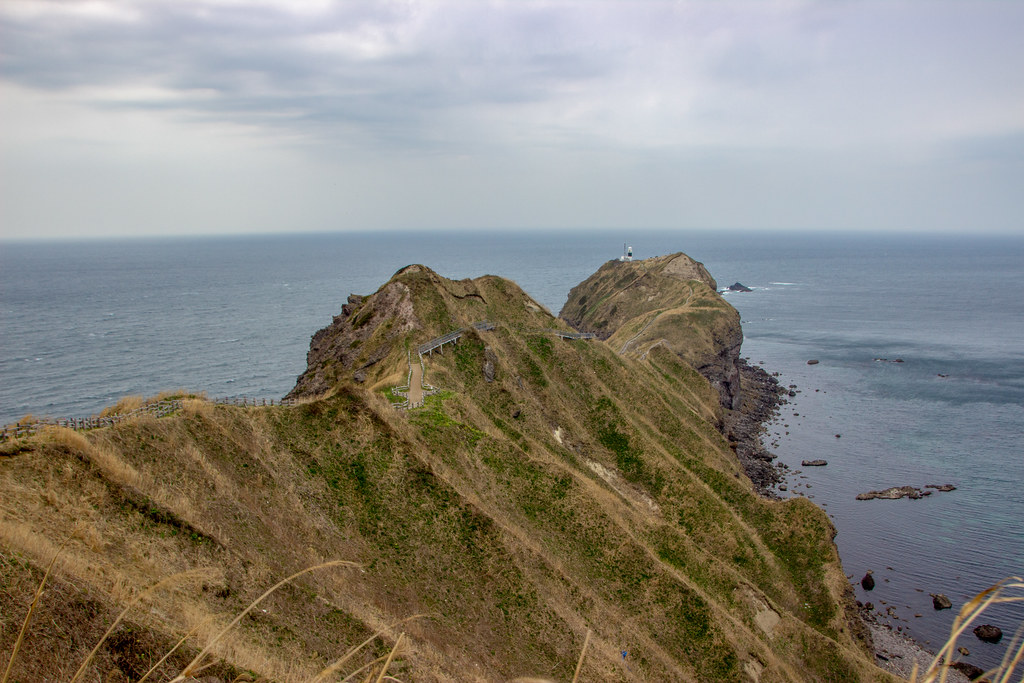Being the northernmost and least developed island of Japan, Hokkaido is a wonderful place to explore. During early spring, I visited Cape Kamui on Shakotan peninsula, Toya-Usu Global Geopark and the charming port city, Hakodate. This island is known for its dramatic landscapes, such as, volcanoes (6 are active), hot springs (onsens) and rugged coastlines. Read on to learn about Hokkaido Japan highlights.
Hokkaido Japan Travel Highlights
Shakotan Peninsula
Majestically jutting out into the Sea of Japan along the rugged coastline is the Shakotan peninsula. Overall, it has 3 great capes: Cape Kamui, Cape Shakotan and Cape Ogon. Its transparent waters undulate a beautiful “Shakotan Blue.” I was blown away (literally) by my windy experience at the precipitous Cape Kamui.
Because of the wind, the precipitous promenade “Small Path of Charenka” to the tip of the cape and its lighthouse was closed. Also, the Shakotan Blue was muted by overcast skies. However, I walked along the shoreline’s windy path to get a clear viewpoint of the cape and beyond, with the snow-capped mountains behind.
“The Legend of Kamui” summarizes about a native Ainu chief’s daughter “Charenka” so distraught by the sudden loss of her lover, that she runs to the tip of the cape. Then, she shouts a curse into the wind, that any woman passing the cape on ship dies. Lastly, she then jumps into the sea and becomes Kamui Rock, near the cape. Superstitiously, this area was off limits to women, because of the curse with a signboard to remind.
Due to the blustery wind, I didn’t cross the gateway to test this hex. Thankfully, many women have proved it wrong over the years. However, everyone should visit with caution because of the moody weather and winds that frequent this intriguing vortex of nature, beauty and legends.
Toya-Usa Global Geopark
Hokkaido Japan Travel Highlights
Overall, the Toya-Usa Global Geopark is an active volcano zone (4 eruptions in the 20th century), along with caldera lakes and hot springs. With the most recent eruption in 1977, the theme here is Shintoism in its highest form, as humanity’s coexistence with the changing earth. On my day trip, I explored the Volcano Village.
First, I walked closely by the young and active Mt. Showa-shinzan “New Mountain in Showa Period.” It stands at 398 metres high. Furthermore, it formed over a 2-year period, following the 1943 eruption of the stratovolcano, Mount Usa.
Mt. Usu Ropeway to Summit Station
I took the Mt. Usu Ropeway (5 minutes) to the Summit Station (733 metres) for a 360-degree panorama of the dramatic landscapes. To the north lies the transparent blue caldera, Lake Toya, nearly circular with a 9-10 km diameter and the Mt. Fuji-like Mt Yotei, dramatically looming in the distance at 1898 metres high. Plus, I observed the nearby Ginnuma crater basin. It is the largest crater created by the 1977 eruption alongside the vast Volcano Bay.
Volcano Bay and Sculpture Park
Volcano Bay (approx. 50 km in diameter) was named by a British Captain at the end of the 18th century, when he viewed the volcanic group (Mt. Esan, Mt. Komagatake, Mt. Usu, and Mt. Tarumae) releasing smoke and gas around the bay. The 17th century was a volatile series of eruptions, that was cataclysmic and consequently buried all the villages in the area with ash.
After leaving the Volcano Village, I wandered along the shores of Lake Toya in the Sculpture Park. This pristine lake is Japan’s 2nd most transparent lake with Nakajima Island and the breathtaking backdrop of the Mt. Fuji-like Mt. Yotei. It is one of the “100 Famous Mountains in Japan.”
Additionally, open air Gurutto Chokoku Koen or Sculpture Park displays 58 pieces harmoniously along the lakeside. It’s theme is “Celebration of Life.”
Hakodate-Fort Goryokaku & Cherry Blossoms
The charming port city, Hakodate, offers an efficient tram to get around and see the sites. Firstly, I strolled along the upbeat Kaiko Street to see their Hakodate Dock Red Brick Warehouses. These warehouses are iconic symbols of the past from over a century ago. Now, they are restored and used for commercial use and restaurants.
Then, I took the tram to Goryokaku, a vast star fort, the main fortress of the Republic of Ezo, where I discovered that this is one of Hokkaido’s most famous cherry blossom viewing areas. Sakura Season is one of the top attractions in Hokkaido. This 5-pointed star shaped fort was based on the work of French architect, Vaubanm. Thus, it allowed for more guns on its walls than a traditional Japanese fort.
Now, it’s a restored pleasant park to wander, especially to see the 1600 cherry trees beginning to bloom along the moat. Plus, there is a tower nearby for visitors to look down upon the star-shaped moat.
Related: How to Plan for a Japan Sakura Season Travel Itinerary
Enjoy Hokkaido!
Japan’s northernmost island is an eclectic, natural wonderland. For example, you can experience majestic mountains, volcanoes, caldera lakes, hot springs, colorful flowers and rugged coastlines-all amidst less crowds. Plus, it provides escapes into 4 distinct seasons of nature at its finest. Therefore, I would love to return and further explore its ever-changing landscapes through a solitary journey in coexistence with its primitive nature.
Read More!
Picturesque Shirakawa Village Highlights During Sakura Season
A Wonderful Day Tour at Osaka Castle & Shitennoji











